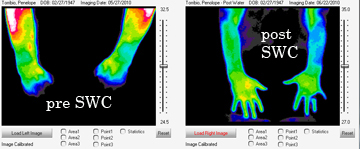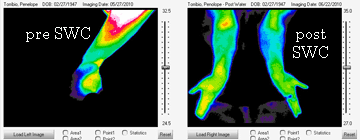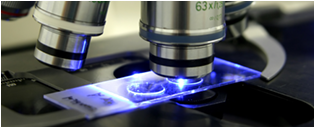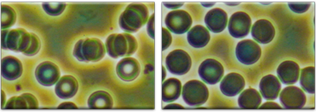We do not claim health cures; however, our research and testimonials point to the idea that drinking even a small amount of stable water clusters may positively affect health and healing.
Experiments Using InfraRed Photography
Before-and-after infrared photos, taken before and then 15 minutes after, drinking stable water clusters (Double Helix Water).
(Please visit these pages for sample images.)
What is Infrared Photography?
Medical DITI is a noninvasive diagnostic technique that allows the examiner to visualize and quantify changes in skin surface temperature. An infrared scanning device is used to convert infrared radiation emitted from the skin surface into electrical impulses that are visualized in color on a monitor. This visual image graphically maps the body temperature and is referred to as a thermogram. The spectrum of colors indicate an increase or decrease in the amount of infrared radiation being emitted from the body surface. Since there is a high degree of thermal symmetry in the normal body, subtle abnormal temperature asymmetries can be easily identified.
Skin blood flow is under the control of the sympathetic nervous system. In normal people, there is a symmetrical dermal pattern which is consistent and reproducible for any individual. This is recorded in precise detail with a temperature sensitivity of 0.1°C by DITI. The neurochemistry application of DITI measures the somatic component of the sympathetic nervous system by assessing dermal blood flow. The sympathetic nervous system is stimulated at the same anatomical location as its sensory counterpart and produces a ‘somato sympathetic response’. The somato sympathetic response appears on DITI as a localized area of altered temperature with specific features for each anatomical lesion.
The mean temperature differential in peripheral nerve injury is 1.5°C. In sympathetic dysfunction’s (RSD / SMP / CRPS), temperature differentials ranging from 1° C to 10° C, depending on severity, are not uncommon. Hematological processes generally appear as ‘hot’ areas with increased temperature patterns. The pathology is generally an inflammatory process, i.e. synovitis of joints and tendon sheaths, epicondylitis, capsular and muscle injuries, etc. Both hot and cold responses may coexist if the pain associated with an inflammatory focus excites an increase in sympathetic activity.
Medical DITI is filling the gap in clinical diagnosis. X-ray, C.T., ultrasound, and M.R.I., etc., are tests of anatomy. E.M.G. is a test of motor physiology. DITI is unique in its capability to show physiological change and metabolic processes. It has also proven to be a very useful complementary procedure to other diagnostic modalities. Unlike most diagnostic modalities DITI is non invasive. It is a very sensitive and reliable means of graphically mapping and displaying skin surface temperature. With DITI you can diagnosis, evaluate, monitor and document a large number of injuries and conditions, including soft tissue injuries and sensory/autonomic nerve fibre dysfunction.
Vascular conditions that are readily demonstrated by DITI include Raynauds disease, Vasculitis, Limb Ischemia, DVT, etc. Also, there is a growing use of thermography for early breast cancer detection. American College of Clinical Thermology
Thermography, as a diagnostic tool, is not universally accepted as a diagnostic tool; however, we are using it as an indicator that there has been change. We are not using infrared photography to identify illnesses.
Computer Hand Injury
The following images are from a subject with a severe computer hand injury.
Her first image did not show fingers; it is speculated that the circulation in her hands was poor. The subject drank two 8-oz glasses of Stable Water Clusters for two weeks. Her post images showed all her fingers and a more even and healthier distribution of color.

Back-of-Hand View Pre- Stable Water Clusters and Post- Stable Water Clusters

Side-of-Hand View Pre- Stable Water Clusters and Post- Stable Water Clusters
Dr. Lo is guessing that there is a movement towards health when the images move from not showing fingers, to showing all fingers and moving towards more evenness in temperature.





